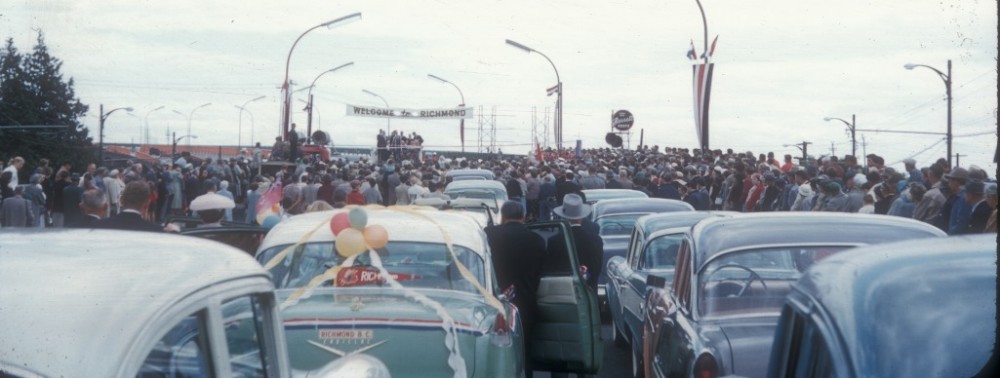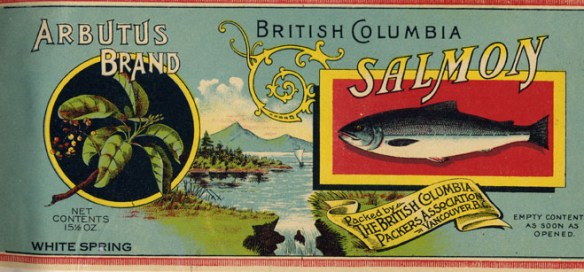The City of Richmond Archives acquired a large number of records of British Columbia Packers Ltd. at the time of the closure of its head office in Steveston. Among the records transferred to the Archives were an extensive series of files relating to the application for, registration, and maintenance of trademarks used and administered by the company and its predecessor and related companies. The records include trademark registrations, correspondence, product packaging, and hundreds of different labels that were in use from 1890 to 1999. Shown in this posting are a few of the trademarked labels owned by BC Packers which illustrate some of the themes used in marketing salmon.

Alexander Ewen was a pioneer in the canning industry on the Fraser River. In 1902 he became the president and largest shareholder of a new firm, The British Columbia Packers’ Association. Shown here is an Ewen Brand Sockeye Salmon label from that era.
From the earliest years of salmon canning, the graphics used on the labels tended to be colourful and eye-grabbing to attract the consumer. Some of the earliest labels were printed in Victoria by the Colonist.

An 1891 Excelsior Brand salmon label. The cannery using this label was at Ladner’s Landing, owned by E.A. Wadhams. The company shipped its product through its agents in San Francisco, D.L. Beck & Sons.
Labels were sometimes printed and applied closer to the final market of the product, the cans being shipped “bright”, ie. without labels.

This label, also from 1891, was printed by the Canada Bank Note Co. in Montreal and included handling instructions in English and in French.
Trademarks had to be registered with the appropriate government department, in the case of Flagship Brand, the Department of Agriculture, Trade Mark and Copyright Branch in Ottawa. The registration document included a complete description of the label as shown below.
The Flagship Brand label was enticing on a number of levels. The “Flagship of modern pattern” and the Ensign and Union Jack made a patriotic connection to the British Motherland. The beautiful, wild British Columbia scenery showed the beauty of the land where the fish was caught, a wilderness tamed by the modern steam train on the right, all surrounded by a bright, eye-catching orange.
The majority of the BC fishery’s output was shipped for sale in Britain and nations of the British Empire, and as such, labels often carried some reference to the Monarchy or the Empire to encourage sale to patriotic shoppers. This could be done symbolically, as in Rex Brand, or directly with the words “British Empire Product” on the label, or in both ways.

Rex Brand Salmon’s trademark, ca. 1906, showed a salmon leaping through a crown. The brand was registered in Australia and New Zealand starting in 1905.

Dominion Brand Salmon labels bore the image of the British Lion with “British Empire Product” written in a banner below. This image was seen on many BC Packers labels.

Emblem Brand, first registered in 1903, also bore the British Empire Lion Logo, as well as a Union Jack and the floral emblems of the United Kingdom. Emblem Brand was registered in Canada, Australia, New Zealand, South Africa, India and France.
Products sold in other countries often had distinct labeling. Rex Pearl was a brand registered in Australia.
Trademarks had to be registered in all the countries where the products were sold. Cascade Brand was a registered trade mark in many countries, including the Netherlands, as shown below.
Labels were often thematic, trying to reach the consumer by appealing to their aesthetics. Many gave colourful representations of the magnificent scenery of British Columbia, sure to catch the discerning housewife’s eye as she did her shopping.

Sunset Brand Chum Salmon, Trademark first registered in 1907, showing beautiful British Columbia scenery.
Occasionally, Canadian stereotypes were used to sell salmon. Nansen Brand in particular used scenes of ice and snow to represent the wild country that the fish came from. The brand was registered in Australia, New Zealand and Canada starting around 1918.
Some labels attempted to evoke feelings of hearth and home and good times with friends. Examples include Dinner Bell, Household and Table Talk brands.

Dinner Bell Brand Fancy Pink Canadian Salmon. Dinner Bell was registered in New Zealand from 1938 to 1951.
Others used sports and other popular modern activities to promote the sales of their products.
Of all the labels used to market salmon, the one with the longest history must be Clover Leaf. One of the best known brands, it was originally registered by a New York company in 1890, being transferred to the British Columbia Packers Association around 1908. The Brand was used on many varieties of canned goods such as vegetables and soups as well as the seafood products that it is best known for. The brand is still in use today, passed on from BC Packers, and can be seen in just about any supermarket.
So, while BC Packers has gone and most of the trademarks controlled by it have vanished, one at least remains to remind us of the company’s long history of quality seafood production and its long connection to Richmond.















Pingback: From Cigarettes to Salmon Tins | Old School Lacrosse